

Glyph-Based Visualization Metrics and Formalizations Rita Borgo Swansea University
History of Visual Communications • Glyph = Greek γλυφή , glyphē , “carving” • Symbols: unit of knowledge representation – Paleolithic Age, 18000 BC • Pre-writing: – Petroglyphs • Hard-wired in human brain ([EM91]) – Pictograms – Ideograms – Logograms
Visual Communications Today… • Pictograms and Ideograms today
Theory of Signs and Sign Systems SIGN = STIMULUS PATTERN + MEANING • Semiosis ( Peirce, [PB55]): process by which a culture produces signs and attributes specific meanings. • Semeiotic ( Eco [Eco 79]): the science of signs, into the conditions which are necessary in order for representations of objects to function as signs.
Semeiotics: Theory of Signs and Sign Systems • Semiosis ( Peirce, [PB55]): process of cooperation between signs, their objects, and their “interpretants” (mental rep.) SIGN = STIMULUS PATTERN + MEANING • Peirce’s Model [PB55]: – Triad: Representamen, Vehicle, Interpretant Chandler [Cha02] • Saussure’s Model [SBSR83]: – Dyad: Signifier, Signified
Sign Systems: Icons, Indices and Symbols • Sign Classification ( Peirce [Pei55]): – Icons: resembles the quality of the object its stands for • Functional Domain: items all share topological similarity with the object they are related. Icon • Examples: images, metaphors and diagrams. – Indices: demonstrates the influence of its object (sensory feature) • Functional Domain: abstractions that rely on a physical cause/effect relation with the object to which they relate to. Index • Examples: clock, thermometer, fuel gauge. – Symbols: is interpreted a reference to its object • Functional Domain: abstractions which rely on a code conventionally used in order to determine meaning. • Examples: mathematical symbols, alphanumeric characters. Symbols
Sign Systems - Codes Code: framework within which signs assume • a meaning. Coding: • – one of the fundamental concepts in semiotics and – represents a deterministic functional relation between a signifier and a signified . Codes ( Chandler [Cha02]): • – Social: verbal languages, body language, commodity and behavioural codes. – Textual: scientific, aesthetic, rhetorical, media. – Interpretative: ideological and perceptual codes (visual perception).
Sign and Glyphs • Are Glyphs signs? Code Sign Meaning (learned rule)
A Formal System: Semiotic Algebra and Grammar Algebra: signs are always part of a formal system • (Saussure [SBSR83], Goguen [Gog03]): – Sorts (subparts of a sign): • colour, location, size; • hierarchical relationships: inheritance, partial ordering etc.; Tensor probe glyph. • constructor rules: – whole/part relationships – generate complex signs = sorts + additional features; – importance rank = partial ordering between constructors. Grammar: syntax of visual signs by Bertin [Ber83] • – First attempt using formal rules. – Six visual primitives (fundamental visual variables). – Each primitive rated in function of the signified Visual Variables [Ber83, Mac04] datasets.
Design Pipeline and Metrics • Design Space: Pettersson [Pet10] “the main goal in information design is clarity of communication; in order to fulfil this goal, all messages must be accurately designed, produced and distributed, and later correctly interpreted and understood by members of the intended audience.” • Design Metrics: Eco [Eco79] “a general semiotic theory should include not only a theory of how codes may establish rules for systems of signification but a theory of how signs may be produced and interpreted to clarify aspects of communications.” + => Design Space Design Metrics Design Process
Design Space – Perceptual Codes • Perceptual Codes: – Gestalt Principles Proximity Similarity • Proximity (> colour similarity) • Similarity • Continuity (> colour similarity) • Closure Continuity Closure • Symmetry • Figure/Ground: – Area (or surroundedness), symmetry, Simmetry parallelism, extremal edges. • Prägnanz (simplest always favoured ) Background/Foreground Prägnanz
Design Space – Visual Channels Visual Channels: • – Primitive visual representations to convey Colour > Size > Shape > Orientation variable values: colour, size, shape, orientation. – Retinal Variables ( Bertin [Ber83]) – Visual Encoding Variables ( Ware [War04]) – Taxonomy by Chen and Floridi [CF12]: Geometric • Optical • Topological/Relational • Semantic • Visual Channels Taxonomy [CF12]
Design Criteria – Metaphoric Associations Maguire et al. [MRSS*12]: • – Semantic Relevance: • Semantic criteria: associative, selective, ordered and quantitative (Bertin, [Ber83]). • Familiarity can support selectivity with almost any shape. – Channel Composition: • Glyphs likely to feature a number of visual channels. • Constructive composition may affect how individual channels are perceived. • Measurable Euclidean Distances. – Pop-out Effects: • Identification of a target within a few nanoseconds of initial exposure to the visual search space. – Visual Hierarchy: • visual system strategies (top-down, bottom-up) vs. • saliency of features
Design Criteria – Visual Orderability • Chung et al. [CLP*13]: – Typedness – Visual Orderability – Channel Capacity – Separability – Searchability – Learnability – Attention Balance – Focus and Context
Design Criteria – Visual Orderability Chung et al. [CLP*13]: Maguire et al. [MRSS*12]: • • – Typedness – Semantic Relevance – Visual Orderability – Channel Composition – Channel Capacity – Pop-out Effects – Separability – Visual Hierarchy – Searchability – Learnability – Attention Balance – Focus and Context
Design Criteria – Normative Ratings Measurements and Norms ( McDougal [MdBC00]) Criteria: • – Concreteness Quantifiable Metrics: • – Visual Complexity – Subjective Rating – Meaningfulness – Icon-based metrics: sum of the – Familiarity components of an icon such as – Sematic Distance letters, lines, arrows etc. Relationship between: • – Automatic visual measure: image – Concreteness vs. visual complexity analysis of icon features such as edge detection, perimeter – Concreteness vs. meaningfulness determination etc. – Meaningfulness vs. familiarity vs. semantic distance
Are Glyphs just Signs? • Glyphs Signs U • Signs: well established theory – Semeiotics: Formal System • Glyph: well established practice – Design Space – Design Metrics • Is that all folks? – Before: Ad-hoc methods based on intuitions – Now: metrics meets challenges (field mature enough)
Recommend
More recommend